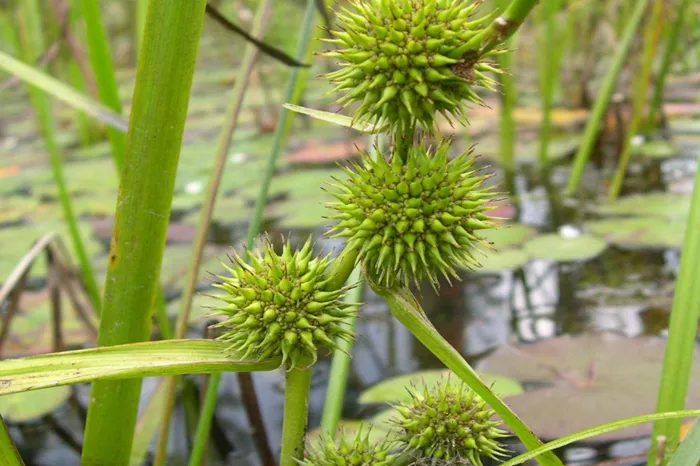The Spiny Green Ping-Pong Ball Plant.
Commonly known as the “spiny, green, ping-pong ball plant,” this perennial aquatic species thrives across much of eastern North America, except for southern Florida. It often forms dense clusters along the edges of ponds, streams, and spring runs. These clusters emerge from slender rhizomes and feature long, bright green leaves. In deeper water or during periods of heavy stream flow, the leaves take on a slender, ribbon-like appearance, gracefully swaying with the current.
The plant blooms in spring and summer, producing a flowering stalk that rises from the clump. These stalks can grow 2 to 3 feet tall and have a zigzagged appearance. The flowers are small and inconspicuous but cluster in compact heads, resembling globes or “balls,” at various points along the stalk. The female flowers form the lower heads, often numbering 5 to 6 in a sequence, with several dozen tightly packed flowers in each head. Each flower is dark green and features several small bracts—similar to petals—at its top. An elongated pistil extends from the ovary, and as the ovaries mature, their bases become hardened and spine-like, creating a dense, round head that appears prickly. The male flowers, which are even smaller, are also grouped into heads, positioned above the female heads along the stalk. Botanists classify both this species and the common cattail in the same plant family due to their similarities.
By early autumn, the female heads fully ripen and shatter during winter, releasing mature, one-seeded fruits still attached by spine-like structures. Waterfowl enjoy these fruits, which have also been used by humans as a wild grain and even a coffee substitute. With their charm, these plants make excellent additions to pool or bog gardens.
However, there is an important caveat. While this plant is a native species in the Southeast and suitable for home gardening, a similar exotic species has emerged in the market that can be quite weedy. If you plan to purchase these plants from a gardening center, ensure that you do not buy Sparganium erectum—the exotic species. Distinguishing between these two can be challenging, so consider consulting the knowledgeable botanists at your local herbarium. Also, remember never to discard aquatic plants into nearby creeks or ponds, as this can lead to the spread of invasive species.
Related topics:
- Plants Engineered by Scientists to Provide Meat-Like Nutrients
- Study Reveals Plants Conserve Energy While Absorbing Potassium
- Protect Your Gardens and Plants from Freezing Winter Nights


